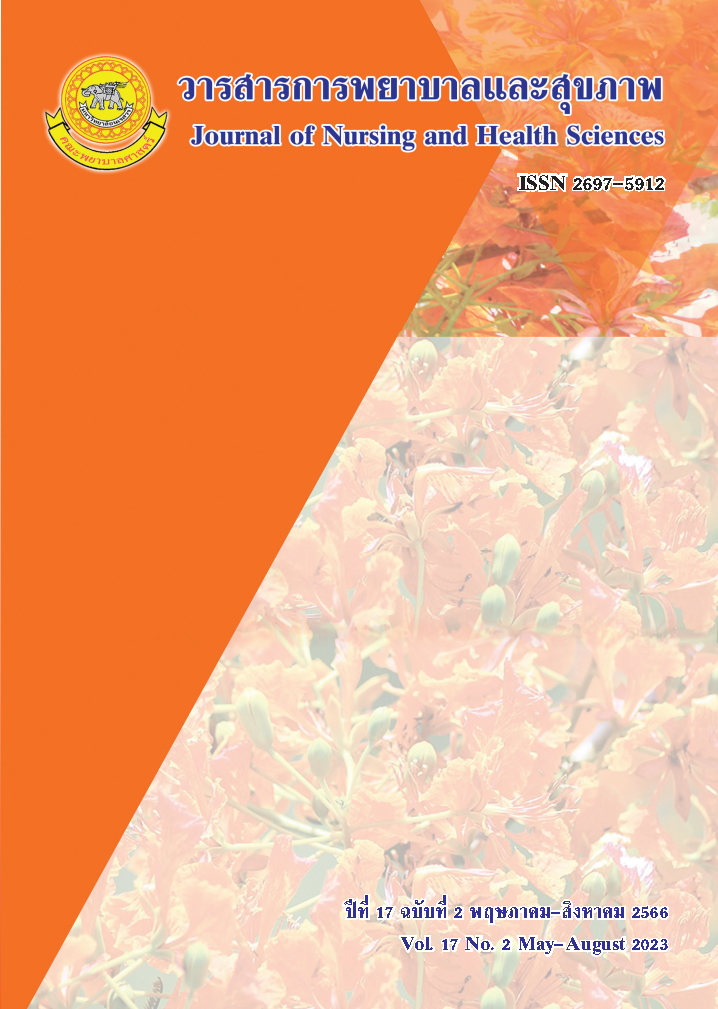ปัจจัยทานายความสามารถในการบริหารความปลอดภัยของพยาบาลวิชาชีพในโรงพยาบาล จังหวัดสมุทรสาคร
Main Article Content
บทคัดย่อ
การวิจัยเชิงทำนาย เพื่อศึกษาปัจจัยทำนายความสามารถด้านการบริหารความปลอดภัยของพยาบาลวิชาชีพโรงพยาบาลกระทุ่มแบน จังหวัดสมุทรสาคร กลุ่มตัวอย่าง คือ พยาบาลวิชาชีพที่ปฏิบัติงานอยู่ในโรงพยาบาลกระทุ่มแบนจังหวัดสมุทรสาคร จำนวน 153 คน เครื่องมือที่ใช้เก็บรวบรวมข้อมูล ได้แก่ (1) แบบสอบถามข้อมูลส่วนบุคคล (2) แบบสอบถามความสามารถด้านการบริหารความปลอดภัยของพยาบาลวิชาชีพ ตรวจสอบคุณภาพเครื่องมือวิจัย ได้ค่า CVI เท่ากับ 0.98 (3) แบบสอบถามทัศนคติด้านความปลอดภัย ค่า CVI เท่ากับ 0.96 (4) แบบสอบถามบรรยากาศองค์การ ค่า CVI เท่ากับ 0.97 และ (5) แบบสอบถามการสร้างเสริมพลังอำนาจ ค่า CVI เท่ากับ 1.00 สถิติที่ใช้ในการวิเคราะห์ข้อมูล ได้แก่ ร้อยละ ค่าเฉลี่ย ส่วนเบี่ยงเบนมาตรฐาน และการวิเคราะห์สมการถดถอยพหุคูณ
ผลการวิจัย พบว่า (1) พยาบาลวิชาชีพที่ปฏิบัติงานอยู่ในโรงพยาบาลกระทุ่มแบนจังหวัดสมุทรสาครมีความสามารถด้านการบริหารความปลอดภัยโดยรวม อยู่ในระดับสูง (= 3.69, SD = 0.52) ทัศนคติความปลอดภัยโดยรวม อยู่ในระดับสูง (= 3.92, SD = 0.46) การรับรู้บรรยากาศองค์การโดยรวม อยู่ในระดับสูง (= 3.86, SD = 0.53) การรับรู้การเสริมสร้างพลังอำนาจโดยรวม อยู่ในระดับสูง (= 3.71, SD = 0.56) และความสามารถด้านการบริหารความปลอดภัยของพยาบาลวิชาชีพ มี ความสัมพันธ์กับการเสริมสร้างพลังอำนาจ (r = .682, P < .01) และสามารถพยากรณ์ความสามารถด้านการบริหารความปลอดภัยของพยาบาลวิชาชีพได้ร้อยละ 46.50 (SEest+ 3.884, R = 0.682 , R2 = 0.465, F = 129.503, p-value = .000) และได้สมการพยากรณ์ ดังนี้ ความสามารถด้านการบริหารความปลอดภัย = 1.336 + 0.637 การเสริมสร้างพลังอำนาจ ผู้วิจัยเสนอแนะว่า ผู้บริหารทางการพยาบาลควรมีนโยบายหรือแนวทางในการเสริมสร้างพลังอำนาจให้กับพยาบาลวิชาชีพ เพื่อให้พยาบาลวิชาชีพสามารถบริหารงานด้านความปลอดภัยให้กับองค์กรได้อย่างมีประสิทธิภาพต่อไป
Article Details

อนุญาตภายใต้เงื่อนไข Creative Commons Attribution-NonCommercial-NoDerivatives 4.0 International License.
เอกสารอ้างอิง
Bandansin, J. (2011). The relationship between
empowerment, teamwork, achievement motivation
and work productivity of professional nurses in The
Royal Thai Army Hospitals. Master Thesis (Nursing
Administration), Sukhothai Thammathirat Open
University, Nonthaburi. [In Thai].
Best, J. W. (1977). Research in education. New Jersey:
Prentice hall Inc.
Boonbumroe, S. (2014). Work safety behaviors of nurse
in Maharat Nakhon Ratchasima Hospital, Nakhon
Ratchasima. The Journal of Boromarajonani College
of Nursing, Nakhonratchasima, 20(2), 82-92. [In
Thai].
Bualuang, B. (2018). Influences of empowerment and
physician – nurse’s relationship on quality of care
of professional nurses at in-patient department,
Uttaradit Hospital. Master Thesis (Nursing Administration), Sukhothai Thammathirat Open University,
Nonthaburi. [In Thai].
Bunrodrux, J., Khumyu, A., & Wongsuttitham, S. (2019).
Factors predicting patient safety competence of
professional nurse in community hospitals, Chon
Buri Province. Royal Thai Navy Medical Journal,
(3), 552-565. [In Thai].
Chaleoykitti, S., Kamprow, P., & Promdet, S. (2014).
Patient safety and quality of nursing service. Journal
of The Royal Thai Army Nurses, 15(2), 66-70. [In
Thai].
Chomchuen , I. (2013). Factors related to the social
empowerment of people in Bangkok Metropolitan
Administration. Master Thesis (Social Development
Administration), National Institute of Development
Administration, Bangkok. [In Thai].
Chunchomgul, C., & Wangsukpisan, A. (2020). Factors
related to the performance of clinical practice for
patient safety among nursing students. The Journal
of Faculty of Nursing Burapha University, 28(4),
-113. [In Thai].
Clifford, P. G. (1992). The myth of empowerment.
Nursing Administration quarterly, 16(3), 1-5.
Deesawat, C., Geerapong, P., & Pensirinapa, N. (2021).
Factors affecting safety behaviors for preventing
novel Coronavirus-2019 infection among personnel
in Buriram Hospital. Regional Health Promotion
Center 9 Journal, 15(38), 399-413. [In Thai].
DeVellis, R.F. (1991) Scale development : theory and
applications. Sage Publications, Inc.
Garcia, T., & Boyer, R. A. (2009). Culture of safety: the
key to successful safety management system (SMS)
implementation and operation. Retrieved 20
February 2023 from https://citeseerx.ist.psu.edu/
document? repid=rep1&type=pdf&doi=70c8e
ba66754e81b45e8c73cf9e39005cc24bb4.
Hwang, J. I. (2015). What are hospital nurse’ strengths
and weakness in patient safety competence? Findings
from three Korean hospitals. International Journal
for Quality in Health Care: Journal of the International Society for Quality in Health Care, 27(3),
-238.
International Civil Aviation Organization [ICAO] (2009).
Safety management manual (SMM), (2nd ed). (Doc
AN/474). Montreal, Canada: ICAO.
International Civil Aviation Organization [ICAO]. (2013).
Safety management manual (SMM), (3rd ed). (Doc
AN/474). Montreal, Canada: ICAO.
Jang, H., & Lee, J.N. (2014). Nurses’ patient safety
competencies in Korea. 25” international nursing
research congress. Retrieved from https://Stti.
confexcom/Stti/congrs 14/webprogram /Paper66909.
html
Jormsri, P., Klunklin, A., Tunmukayakul, O., & Srisuphan,
W. (2010). Perception of nursing principles among
nurses in Thailand. Thai Journal of Nursing Council,
(1), 27-37. [In Thai].
Kalantagaphan, P., Suwonnakote, K., & Monaiyapong,
P. S. (2014). The relationship between organizational
climate and work happiness of professional nurses
at a hospital under the Bangkok Metropolitan
Administration. Thai Journal of Nursing, 63(4),
–48. [In Thai].
Kanter, R. M. (1993). Men and woman of the corporation
(2nd ed.). New York: Basic Books.
Keller, B.J. (1991). A study of empowering nurse within
the context of health care organization. Doctoral
Disscertation, University of Colorado Health Science
Center, Colorada, USA.
Manser, T. (2009) Teamwork and patient safety in
dynamic domains of healthcare: a review of the
literature. Acta Anaesthesiologica Scandinavica,
(2), 143-151.
Nualkhaow, P. (2009). The Relationship between head
nurses’ administrative roles and the organizational
climate as perceived by professional nurses at
community hospitals in the southern region. Master
Thesis (Nursing Administration), Sukhothai
Thammathirat Open University, Nonthaburi. [In
Thai].
Polit, F.D., & Hungler, P.B. (1999). Nursing research:
principles and methods (6th ed.). Philadelphia, PA :
Lippincott Company.
Pitchayayothin, N. (2017). Developmental psychology.
Retrieved 19 February 2023 from https://www.psy.
chula.ac.th/th/feature-articles/devpsy. [In Thai].
Putpan, W. (2013). The influence of perceived safety
culture and obtaining job empowerment on risk
management practices of professional nurses in
community hospital area 13. Medical Journal of
Yasothon Hospital, 13(2), 89-99. [In Thai].
Seangon, L., Srithumma, N., Wongkhomthong, J., &
Meehanpong, P. (2018). The safety management
model of nursing organization at the tertiary -level
hospitals in Thailand. Christian University of
Thailand Journal, 24(4), 516-529. [In Thai].
Singjai, S., Pensirinapa, N., & Sitakalin, P. (2016). The
relationships between personal factors, organizational
climate and personnel participation in risk
management in community hospitals, Chiang Mai
Province., 43(Supplement), 162-172. [In Thai].
Stringer, R. (2002). Leadership and organization climate
: the cloud chamber effect. New Jersey: McGraw-Hill.
Yamane, T. (1967). Statistics: an introductory analysis
(2nd ed.). New York.: Harper and Row.
The Healthcare Accreditation Institute (Public
Organization), (2023). Certification history
information. Retrieved 19 February 2023 from http://
www.ha.or.th/EN/Hospitals/Certificate%20Status/
Details/12 [In Thai].


